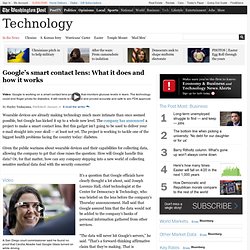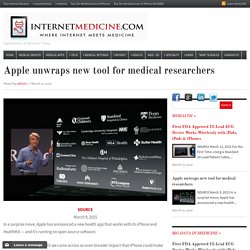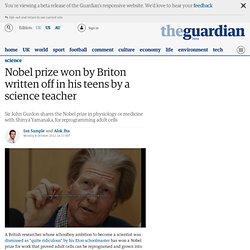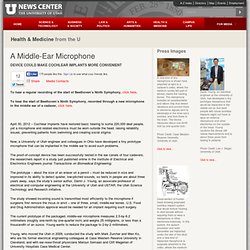

Google’s smart contact lens: What it does and how it works. It’s a question that Google officials have clearly thought a lot about, said Joseph Lorenzo Hall, chief technologist at the Center for Democracy & Technology, who was briefed on the lens before the company’s Thursday announcement.

Hall said that Google assured him that the data would not be added to the company’s banks of personal information gathered from other services. “The data will never hit Google’s servers,” he said. “That’s a forward-thinking affirmative claim that they’re making. That is important.” The soft contact lens that Google is unveiling — it’s still a prototype — houses a sensor that measures the glucose levels in tears. Given the sensitive nature of the data, Hall said, Google has also said it will make sure any data transferred from the lens cannot be manipulated — something that could have potentially fatal consequences if patients inject the wrong amount of insulin.
“One thing I do worry about is mobile security itself. Apple unwraps new tool for medical researchers. In a surprise move, Apple has announced a new health app that works with its iPhone and HealthKit — and it’s running on open-source software.

“As we worked on HealthKit we came across an even broader impact that iPhone could make and that is on medical research,” Apple CEO Tim Cook said during a live event. “Perhaps the most profound change iPhone will make is on our health.” With the ResearchKit app, Apple intends for the software framework to enable more people to participate in research, and for innovators to build apps on top of Apple’s platform.
The company also revealed five apps already available. Nobel prize won by Briton written off in his teens by a science teacher. A British researcher whose schoolboy ambition to become a scientist was dismissed as "quite ridiculous" by his Eton schoolmaster has won a Nobel prize for work that proved adult cells can be reprogramed and grown into different tissues in the body.

Sir John Gurdon, 79, of Cambridge University, shares the prize in physiology or medicine - and 8m Swedish kronor (£744,000) cash - with the Japanese scientist Shinya Yamanaka, 50, who holds academic posts at the Universities of Kyoto and San Francisco. The groundbreaking work has given scientists fresh insights into how cells and organisms develop, and may pave the way for radical advances in medicine that allow damaged or diseased tissues to be regenerated in the lab, or even inside patients' bodies. Gurdon heard he might have won science's highest honour from a journalist on an Italian newspaper who called his lab at 7.30am on Monday morning, before the announcement had been made. An hour later, he received the official call from Stockholm. Fighting Disease by Growing New Tissues. For most of us, minor wounds are just an inconvenience.

We endure the minor pain of a cut or scrape, stick on a bandage, and within a week, our skin looks like nothing ever happened. In some cases, though, healing isn’t so simple. Somewhere along the way, the complex chain of events that lets the body repair itself breaks down, and a wound remains open, raw. Such is the case with those who suffer from chronic foot ulcers, a non-healing wound common in diabetics. “For these foot ulcers, there are a variety of therapies, but they are only successful in roughly half the cases, and [the ulcers] have a high recurrence rate,” says Jonathan Garlick, head of the Division of Cancer Biology and Tissue Engineering at Tufts School of Dental Medicine. Garlick’s research could one day help patients avoid that kind of traumatic outcome. “There are millions of patients suffering from chronic, non-healing conditions like these,” says Garlick, a professor of oral and maxillofacial pathology.
A Middle-Ear Microphone. To hear a regular recording of the start of Beethoven’s Ninth Symphony, click here.

To hear the start of Beethoven’s Ninth Symphony, recorded through a new microphone in the middle ear of a cadaver, click here. April 30, 2012 – Cochlear implants have restored basic hearing to some 220,000 deaf people, yet a microphone and related electronics must be worn outside the head, raising reliability issues, preventing patients from swimming and creating social stigma. Now, a University of Utah engineer and colleagues in Ohio have developed a tiny prototype microphone that can be implanted in the middle ear to avoid such problems. First Bionic Eye Sees Light of Day in U.S. After years of research, the first bionic eye has seen the light of day in the United States, giving hope to the blind around the world.

Developed by Second Sight Medical Products, the Argus II Retinal Prosthesis System has helped more than 60 people recover partial sight, with some experiencing better results than others. Consisting of 60 electrodes implanted in the retina and glasses fitted with a special mini camera, Argus II has already won the approval of European regulators. The US Food and Drug Administration is soon expected to follow suit, making this bionic eye the world's first to become widely available.
PHOTOS: Mechanimals: Animals Fitted With Prosthetics.